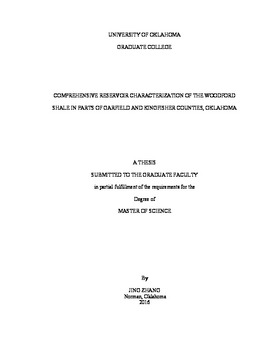| dc.description.abstract | This research is a comprehensive characterization of the Woodford Shale within an area of six townships and ranges located at the boundary of Garfield and Kingfisher Counties in Oklahoma.
The methods of the Woodford Shale reservoir characterization include: sequence stratigraphy interpretation, well log interpretation, X-ray diffraction (XRD) and X-ray fluorescence (XRF) analysis on drill cuttings, Rock-Eval organic geochemistry analysis and microseismic interpretation.
The interpretation results of these methods provided detailed characteristics of the Woodford Shale. Seven third order parasequences were identified within the Woodford based on the well logs. The lower parasequences were more likely to be deposited where there was a paleo-topographic low, and there is an inverse relationship of thickness between the Woodford and Sylvan Shale. The mineral composition obtained from drill cuttings shows that the Woodford Shale has high clay content mainly composed of illite and kaolinite, moderate quartz content derived both from biogenic radiolaria and detrital quartz. The percentage of quartz highly affects the brittleness of the formation and ultimately affects the efficiency of hydraulic fracturing. From the thin section analyses, there are five types of Woodford Shale cuttings identified based on different mineral composition and internal structure. The chemostratigraphic analysis based on the horizontal well XRF profile defined 12 chemofacies. The 12 chemofacies were interpreted and related to sequence stratigraphy and sea level fluctuations. The XRF datasets are also correlated with XRD-derived mineral data and calculated brittleness. The organic geochemistry aspect indicated that Woodford is an organic-rich shale with high TOC value and it is within the oil thermal maturation window due to the shallower burial depth than the Woodford in the Anadarko Basin.
The microseismic data interpretation of one horizontal well indicates that there is a relationship between the sequence stratigraphic framework and the microseismic event distribution. In the highstand system tract (brittle zone), the fractures are more prone to stay within the target formation and grow horizontally to enhance the fracturing efficiency. When the stimulation occurs within the transgressive system tract (ductile zone), the perforation energy will be absorbed by the formation and reduce the fracturing efficiency. From the image log and microseismic distribution patterns, the local stress field was interpreted. The maximum horizontal stress direction is N80E. To get better fracturing effect in the future, nearby well is should be drilled perpendicular to the maximum horizontal stress direction, or N10W.
Overall, the Woodford Shale in the study area is a high potential and high quality unconventional reservoir for exploration and development. The well placement and fracturing plan design need to consider the sequence stratigraphy and heterogeneity within the reservoir in order to enhance drilling efficiency and hydrocarbon production. | en_US |
